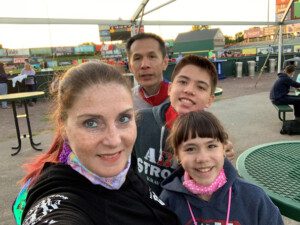Written by Laura Low for the RSDSA blog. Submitted by Abbott, a sponsor of RSDSA.
 In January 2018, my world was turned upside down after doctors told me I had a ganglion cyst on my foot. Prior to that, my life was adventurous and, in a word, awesome! As a wife, mother of twins and having a fun job of being a travel agent, things were going well.
In January 2018, my world was turned upside down after doctors told me I had a ganglion cyst on my foot. Prior to that, my life was adventurous and, in a word, awesome! As a wife, mother of twins and having a fun job of being a travel agent, things were going well.
Once I was diagnosed, my foot doctor insisted I have the cyst removed right away and schedule the procedure. After the surgery, I was in pain and was not healing well. I was left bed-bound, without being able to put any pressure on my foot. I could not wear a sock, shoe, or have my sheets touch me.
I had planned a trip to Disney for my twins’ 10th birthday and to run the Disney 5K through Magic Kingdom but had to cancel it and was heartbroken. Having to tell them I had to cancel their 10th birthday plans was horrible. My kids could see that I was broken, and, physically and mentally, I was.
I went to all types of special doctors to find out what could be done for me. After lots of appointments, I finally found out I had CRPS II, also known as post-surgical causalgia, following the cyst removal. I tried physical therapy, mental therapy, and mirror therapy. I was on so many medications, taking more than 20 tablets daily, I had to have a doctor help manage them for me.
The pain caused me to be a shell of who I was. I lost people I thought were friends, my kids accepted the fact that I was not their fun mom anymore, and, during all of this, I lost my job.
In June 2019, I had a spinal cord stimulator implanted. After recovering from the procedure, I was able to walk from my front door to my mailbox, which was HUGE for me. I felt like I was given a break. However, I still lived with the pain from CRPS and was not living my full life.
It wasn’t until two years later when I was at a follow up with my doctor for a steroid injection in my lower back that he mentioned dorsal root ganglion (DRG) stimulation. He told me it would be able to address a specific bundle of nerves in my spine which could give me more direct coverage1. I was willing to try anything that would offer me any type of relief.
This was especially important, because at the same time, my husband was preparing to donate a kidney to our brother-in-law. This life changing surgery had a large impact on our family, and I wanted to be able to distract my kids from everything that was going on.
When I was getting ready for the surgery, the medical team asked me my level of pain and what I hoped it to be after. I explained to them that it was more than just a number, it was about my quality of life. I wanted to be able to wear socks and shoes, walk around my block, have sand on my feet, and enjoy things I did before my pain started. These things are little to so many people and are taken for granted, but for me, they were everything.
After recovering from the surgery, I am happy to say that I have walked on the beach in Mexico, gone ziplining, and have had other fun adventures with my kids. I have felt my personality come back, but the best part is that my family feels that way too! My kids and my husband feel that their FUN mom is back!
When my husband was still in the hospital, I was able to take my kids to the zoo and walked around for five and a half miles. ME – the same person that three weeks before could not walk around a store, or the block, could now walk for hours and miles!
I can’t say that the DRG stimulator is going to work for everyone, but honestly, it really changed my life for the better. I wish, hope, and pray that anyone that tries it is as successful as I have been.
Learn more about DRG therapies and how to find a pain specialist near you.
If you think neurostimulation might be right for you, consult your doctor to discuss the risks and benefits. This story represents one patient’s experience with neurostimulation. While most patients experience at least some reduction in pain, the amount varies among individuals. The surgical placement and use of a neurostimulation system pose risks, which also vary by individual.
MAT-2208350 v1.0 2022
1Deer TR, Levy RM, Kramer J, et al. Dorsal root ganglion stimulation yielded higher treatment success rate for complex regional pain syndrome and causalgia at 3 and 12 months: a randomized comparative trial. Pain. 2017; 158(4):669-681. (n=152)
